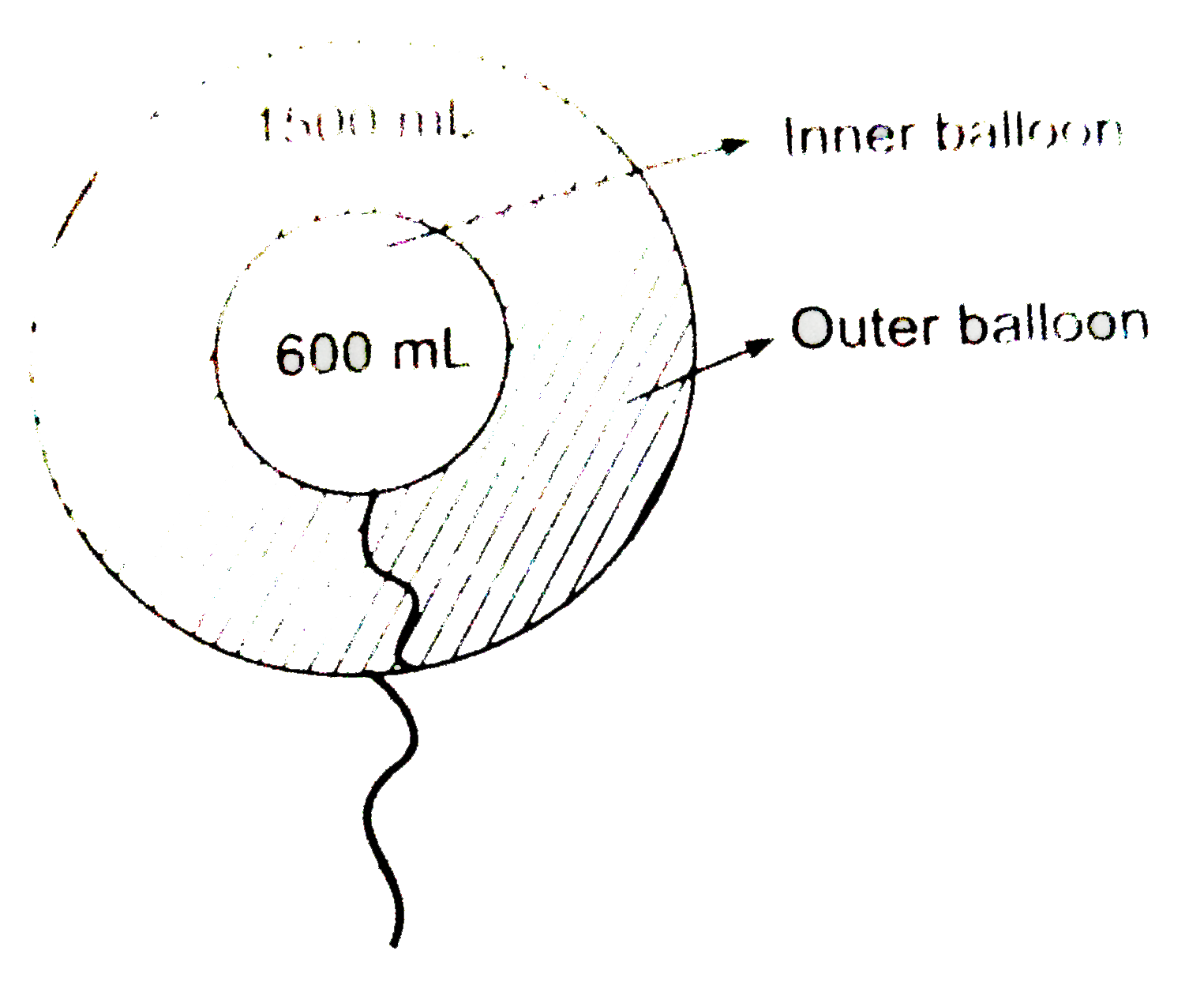A balloon blown up has a volume of 500 mL at 5∘C. The balloon is distended to 7/8th of its maximum capacity.
Will it burst at 30∘C ?
To determine whether the balloon will burst at 30°C, we can use Charles's Law, which states that the volume of a gas is directly proportional to its temperature (in Kelvin) when pressure is constant.
1. Identify Given Values:
- Initial volume of the balloon (V1) = 500 mL
- Initial temperature (T1) = 5°C = 5 + 273 = 278 K
- The balloon is distended to 7/8 of its maximum capacity.
- Let the maximum capacity of the balloon be V_max.
2. Calculate Maximum Capacity (V_max):
- Since the balloon is at 7/8 of its maximum capacity when it has a volume of 500 mL, we can set up the equation:
78Vmax=500mL
- Solving for V_max:
Vmax=500×87=571.43mL
3. Set Up Charles's Law:
- According to Charles's Law:
V1Vmax=T1T2
- We need to find the temperature (T2) at which the balloon will burst (when V = V_max).
4. Substitute Known Values:
- Substitute V1 = 500 mL, V_max = 571.43 mL, and T1 = 278 K into the equation:
500571.43=278T2
5. Cross-Multiply and Solve for T2:
- Cross-multiplying gives:
500⋅T2=278⋅571.43
- Now calculate:
T2=278⋅571.43500≈317.71K
6. Convert T2 to Celsius:
- Convert T2 back to Celsius:
T2=317.71−273≈44.71°C
7. Conclusion:
- The balloon will burst at approximately 44.71°C. Since 30°C is lower than 44.71°C, the balloon will not burst at 30°C.
Final Answer:
The balloon will not burst at 30°C.
- Initial volume of the balloon (V1) = 500 mL
- Initial temperature (T1) = 5°C = 5 + 273 = 278 K
- The balloon is distended to 7/8 of its maximum capacity.
- Let the maximum capacity of the balloon be V_max.
- Since the balloon is at 7/8 of its maximum capacity when it has a volume of 500 mL, we can set up the equation:
78Vmax=500mL
- Solving for V_max:
Vmax=500×87=571.43mL
- According to Charles's Law:
V1Vmax=T1T2
- We need to find the temperature (T2) at which the balloon will burst (when V = V_max).
- Substitute V1 = 500 mL, V_max = 571.43 mL, and T1 = 278 K into the equation:
500571.43=278T2
- Cross-multiplying gives:
500⋅T2=278⋅571.43
- Now calculate:
T2=278⋅571.43500≈317.71K
- Convert T2 back to Celsius:
T2=317.71−273≈44.71°C
- The balloon will burst at approximately 44.71°C. Since 30°C is lower than 44.71°C, the balloon will not burst at 30°C.
The balloon will not burst at 30°C.
Topper's Solved these Questions
- STATES OF MATTER : GASES AND LIQUIDSBOOK - ICSECHAPTER - STATES OF MATTER : GASES AND LIQUIDSEXERCISE - VERY SHORT ANSWER TYPE QUESTIONS
20 Videos
- STATES OF MATTER : GASES AND LIQUIDSBOOK - ICSECHAPTER - STATES OF MATTER : GASES AND LIQUIDSEXERCISE - SHORT ANSWER TYPE QUESTION
23 Videos
- STATES OF MATTER : GASES AND LIQUIDSBOOK - ICSECHAPTER - STATES OF MATTER : GASES AND LIQUIDSEXERCISE - NCERT TEXT-BOOK EXERCISES (With Hints and Solutions)
23 Videos
- SOME P-BLOCK ELEMENTS BOOK - ICSECHAPTER - SOME P-BLOCK ELEMENTS EXERCISE - NCERT TEXTBOOK EXERCISES (With Hints and Solutions)
63 Videos
- STRUCTURE OF ATOMBOOK - ICSECHAPTER - STRUCTURE OF ATOMEXERCISE - NCERT Textbook Exercises
67 Videos
Similar Questions
A balloon blown up has a volume of 500 mL at 5∘C. The balloon is distended to 7/8th of its maximum capacity.
Calculate the minimum temperature above which it will burst.
View SolutionA bolloon blown up has a volume of 300 mL at 27% C. The balloon is distended to 56 of its maximum stretching capacity. The maximum temperature above which it will burst is
View SolutionA balloon has 5.0 mole of helium at 7∘C. Calculate
(a) the number of atoms of helium in the balloon.
(b) the total internal energy of the system.
View SolutionA gas occupies 500 mL at 25∘C and 745 mm pressure. What would be its volume at S.T.P.?
View SolutionA bakelite beacker has volume capacity of 500ccat30∘C. When it is partially filled with Vm volumne (at 30∘C) of mercury, it is found that the unfilled volume of the beaker remains constant as temperature is varied. If γbeaker=6×10−6.∘C−1 and γmercury=1.5×10−4.∘C−1 , where γ is the coefficient of volume expansion , then Vm (in cc) is close to __________.
View SolutionA diatomic gas which has initial volume of 10 liter is isothermally compressed to 1/15th of its original volume where initial pressure is 105 Pascal. If temperature is 27∘C then find the work done by gas
View SolutionA balloon containing an ideal gas has a volume of 10litre and temperature of 17∘. If it is heated slowly to 75∘C, the work done by the gas inside the balloon is (neglect elasticity of the balloon and take atmospheric pressure as 105 Pa)
View SolutionA balloon has 5.0 g mole of helium at 7∘C Calculate
(a) the number of atoms of helium in the balloon,
(b) the total internal energy of the system.
View SolutionAssuming the same pressure in each case calculate the mass of hydrogen required to inflate a balloon to a certain volume V at 100∘C if 3.5g helium is required to inflate the balloon to half the volume V at 25∘C .
View SolutionTwo inflated ballons I and II (thin skin) having volume 600 mL and 1500 mL at 300 K are taken as shown in diagram. If maximum volume of inner and outer balloons are 800 mL and 1800 mL respectively then find the balloon which will burst first on gradual heating.

View Solution
